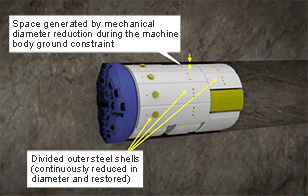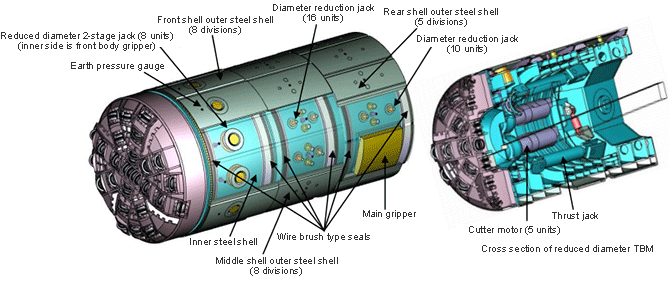Overview
The disadvantage of tunnel boring machines (TBMs), which are capable of high-speed construction compared to the conventional mountain tunneling method, is the risk of ground collapse when fault zone, etc. are encountered in the excavation site, or the risk of the machine body being restrained and unable to excavate due to adhesion of debris rocks during hard rock cutting. In order to release the constrained condition, it is necessary to cut and expand the restrained ground by human power after taking measures to prevent the ground from collapsing under water pressure or earth pressure. However, this work is dangerous, inefficient, and requires a long period of time, because it is necessary for workers to go outside the excavator, build supports over the entire length of the excavator to cover the restrained excavator, and then release the restraint. Taking these factors into consideration, we have developed the tunnel boring machine (TBM) with a function to mechanically reduce and restore the diameter, which enables early escape from the ground constraint state.Advantages
Conventional excavator restraint release work, like the above method, is dangerous and requires a long period of time, which puts pressure on the construction period and costs. In order to solve these problems, the outer diameter of the excavator can be reduced, and the following advantages can be obtained by escaping from the ground constraint and restoring it Fig. 1 Outline of TBM excavation for diameter reduction and restoration
Fig. 1 Outline of TBM excavation for diameter reduction and restoration
When the excavator is restrained, the restraint can be easily released by reducing the fuselage diameter without manual labor.
The mechanism for diameter reduction (restoration) can be operated from the operation panel using electric signals that control the hydraulic system.
By constantly monitoring the earth pressure acting on the fuselage with earth pressure gauges installed on the outer steel shells, it is possible to take action from the early stage of restraint, and avoid the danger area while monitoring and excavating.
By using a hydraulic mechanism, it is possible to freely adjust the contraction and reduced weight (restoration amount) as many times as desired.
TBMs have been considered to have a high risk of tunnel excavation, but with the new technology of diameter reduction (restoration) structure, both safety and construction period will be dramatically improved compared to the conventional restraint release methods.
The mechanism for diameter reduction (restoration) can be operated from the operation panel using electric signals that control the hydraulic system.
By constantly monitoring the earth pressure acting on the fuselage with earth pressure gauges installed on the outer steel shells, it is possible to take action from the early stage of restraint, and avoid the danger area while monitoring and excavating.
By using a hydraulic mechanism, it is possible to freely adjust the contraction and reduced weight (restoration amount) as many times as desired.
TBMs have been considered to have a high risk of tunnel excavation, but with the new technology of diameter reduction (restoration) structure, both safety and construction period will be dramatically improved compared to the conventional restraint release methods.
Features
~Reduces and restores outer diameter to facilitate escape from ground restraint~
Main features of the excavator (see Fig. 2)- The excavator is equipped with a segmented outer steel shells with a reducible diameter (restorable) structure based on the fixed lower part around the front, middle and rear bodies of the excavator.
- Each of the divided outer steel shells is equipped with a reduced diameter (restoration) jack to secure the amount of diameter reduction.
- The lower gripper and the jack for diameter reduction (restoration) are two-stage jacks as the front body gripper, and the second stage has a gripper function.
- To prevent the inflow of sediment into the gap between the outer and inner steel shells, the joints were overlapped, and the gap between the outer and inner steel shells is a two-stage wire brush-type seal, with automatic greasing between them.
- Each structure steel shells division is equipped with multiple earth pressure gauges to detect the compaction status of the ground.
 Outline of reduced diameter and restoration TBM excavation
Outline of reduced diameter and restoration TBM excavation